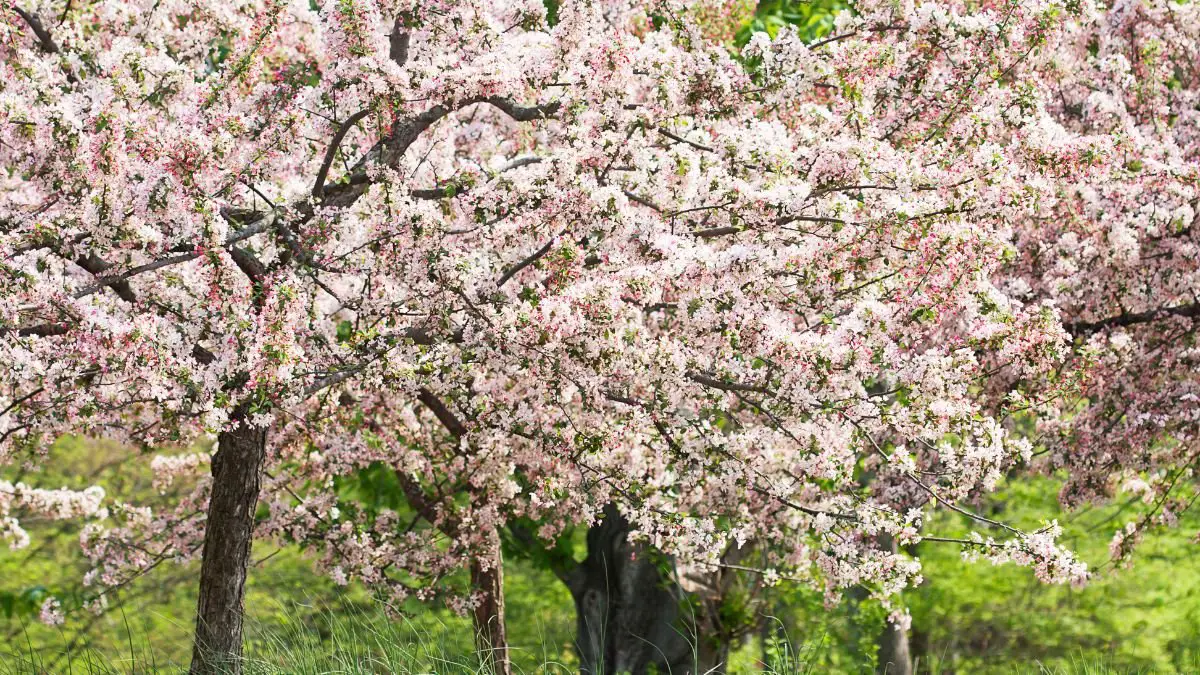Curious about the growth rate of crabapple trees? Understanding the speed at which these trees grow can help you plan your garden effectively. Crabapple trees, known for their vibrant blossoms, fruits, and crabapples, have varying growth rates influenced by factors like species, environment, care, and cultivars. By grasping how quickly they grow, you can anticipate when to expect blooms and fruit production in your outdoor space.
Delving into the growth patterns of crabapple trees offers insights into nurturing these beautiful additions to your landscape. Whether you are a seasoned gardener or a novice enthusiast, knowing the pace of growth for crabapple trees equips you with the knowledge needed to cultivate a thriving garden. Stay tuned to discover more about the fascinating growth journey of crabapple trees.
Understanding Crabapple Growth
Growth Factors
Crabapple trees' growth is influenced by sunlight, soil quality, and water availability. Adequate sunlight is crucial for photosynthesis, while nutrient-rich soil supports healthy root development. Proper watering ensures optimal growth.
Pruning plays a vital role in promoting healthy growth of crabapple trees. It helps shape the tree, remove dead or damaged branches, and improve air circulation. Pruning also stimulates new growth and enhances overall tree health.
Typical Rates
On average, crabapple trees can grow at a rate of 1 to 2 feet per year under optimal conditions. The growth rate may vary depending on the specific cultivar and environmental factors. In ideal settings, these trees can reach maturity within a few years.
In optimal conditions, crabapple trees exhibit rapid growth, with significant height and canopy expansion within a short period. Understanding the typical growth rates of these trees allows for better planning when landscaping or caring for them in a garden or orchard setting.
Variability Conditions
Environmental conditions such as temperature, humidity, and precipitation can significantly impact the growth of crabapple trees. Extreme weather events like frost or drought can stunt growth or damage the tree. Adapting care routines based on changing conditions is essential for ensuring tree health.
Weather patterns play a crucial role in determining the success of crabapple tree growth. By monitoring local climate trends and adjusting care practices accordingly, gardeners and arborists can help mitigate potential challenges that may arise due to fluctuating environmental conditions.
Optimal Conditions for Growth
Light Essentials
Proper sunlight exposure is crucial for crabapple tree growth, ensuring photosynthesis and overall health. Without adequate light, trees may struggle to produce energy efficiently. To promote optimal development, ensure that the trees receive at least six hours of direct sunlight daily.
Inadequate light can lead to stunted growth and poor fruit production in crabapple trees. To prevent this, consider pruning nearby branches that block sunlight or planting trees in open areas with ample light exposure. Insufficient light can weaken the tree's immune system, making it more susceptible to diseases.
Soil Needs
Crabapple trees thrive in well-draining soil rich in organic matter. The ideal soil pH for these trees ranges between 6.0 and 7.0, promoting nutrient absorption and healthy root development. Compacted or waterlogged soil can hinder root growth and nutrient uptake.
To enhance soil quality for crabapple trees, incorporate organic matter like compost or mulch to improve drainage and provide essential nutrients. Regularly test the soil pH levels to ensure they remain within the optimal range for proper tree growth. Avoid planting crabapple trees in clayey or sandy soils that may impede root expansion.
Watering Practices
Balanced watering is key to supporting crabapple tree growth, preventing both dehydration and waterlogging issues. These trees require consistent moisture levels, especially during dry periods, to thrive. Overwatering can lead to root rot, while underwatering causes stress and leaf wilting.
To maintain optimal moisture levels, water crabapple trees deeply but infrequently, allowing the soil to dry slightly between watering sessions. Monitor the soil moisture by checking the top few inches regularly; if it feels dry to the touch, it's time to water again. Signs of overwatering include yellowing leaves and a foul smell emanating from the soil.
Temperature and Humidity
Temperature and humidity play vital roles in crabapple tree growth, influencing flowering, fruiting, and overall health. Extreme temperature fluctuations can damage tender buds and young shoots, affecting future growth potential negatively. Ideal temperatures range between 60°F to 70°F, promoting healthy foliage development.
To protect crabapple trees from temperature extremes, consider using mulch around the base of the tree to regulate soil temperature. Avoid planting trees in low-lying areas prone to frost pockets that may harm delicate blossoms. Maintaining moderate humidity levels around 50% enhances leaf hydration without encouraging fungal diseases.
Enhancing Growth
Pruning Tips
Pruning crabapple trees is crucial for their health and growth. Proper pruning techniques involve removing dead or diseased branches to encourage new growth. Timing is key; prune during late winter or early spring before new growth appears.
Understanding the significance of pruning can prevent diseases from spreading and improve air circulation within the tree. By cutting back excess growth, you allow more sunlight to reach the inner branches, promoting overall tree health.
- Prune annually to maintain a balanced shape and stimulate new growth.
- Avoid over-pruning as it can stress the tree and hinder its development.
Fertilization Guide
Fertilization plays a vital role in supporting the growth of crabapple trees. Choosing the right type of fertilizer rich in nitrogen, phosphorus, and potassium can provide essential nutrients for robust growth. Apply fertilizer in early spring before new growth emerges for optimal absorption.
Different types of fertilizers, such as slow-release granular fertilizers or liquid fertilizers, can be used based on your preference and soil conditions. Regular fertilization every spring helps replenish nutrients in the soil, ensuring healthy tree development.
- Use organic fertilizers for sustainable long-term soil health.
- Test your soil to determine specific nutrient deficiencies before fertilizing.
Propagation Techniques
Exploring propagation methods allows you to expand your crabapple tree collection. Propagating from cuttings is a common technique where healthy stem cuttings are rooted in moist soil or water until they develop roots. This method ensures genetic similarity with the parent tree.
While propagation offers an inexpensive way to grow new trees, it also presents challenges such as susceptibility to diseases and pests during the rooting process. However, with proper care and monitoring, successful propagation can lead to a diverse array of crabapple varieties in your garden.
- Experiment with different propagation methods like grafting for unique tree characteristics.
- Monitor newly propagated trees closely for signs of stress or disease.
Special Care Tips
Overwintering Strategies
When winter approaches, protect your crabapple trees by mulching around the base to insulate roots. Covering the tree with burlap can shield it from harsh winds and snow. Prune any damaged branches before winter to prevent further stress on the tree.
Prepare for cold weather by watering your crabapple trees adequately in late fall. Well-hydrated trees are more resilient to freezing temperatures. Avoid fertilizing in late summer or fall as it can stimulate new growth that may not harden off before winter.
To minimize risks of winter damage, ensure your tree is healthy and well-maintained throughout the year. Regularly inspect for signs of disease or pest infestations, addressing any issues promptly. Proper pruning in early spring can also promote tree vigor and resilience.
Pest and Disease Management
Common pests like aphids and diseases such as apple scab can harm crabapple trees. Monitor your trees regularly for signs of infestation or infection, including distorted leaves or black spots. Use natural remedies like neem oil or insecticidal soap to manage pests effectively.
Preventive measures include planting disease-resistant varieties and maintaining good air circulation around the tree. Remove fallen leaves in autumn to reduce the spread of diseases like apple scab. If needed, consult with a local arborist for professional advice on pest and disease control.
Early detection is key to preventing widespread damage from pests and diseases. Inspect your trees frequently during the growing season for any abnormalities. Swift intervention with appropriate treatments can help save your crabapple trees from severe infestations or infections.
Encouraging Flowering
Promote flowering in crabapple trees by ensuring they receive adequate sunlight and water. Prune dead or overcrowded branches to improve air circulation and light penetration within the canopy. Apply a balanced fertilizer in early spring to support healthy growth and blooming.
Enhance blooming by avoiding excessive nitrogen fertilization, which can lead to lush foliage at the expense of flowers. Mulch around the base of the tree to retain moisture and regulate soil temperature, promoting optimal flowering conditions. Monitor soil pH levels to ensure they are suitable for crabapple trees.
Factors like improper pruning, nutrient deficiencies, or environmental stressors can inhibit flowering. Address these issues promptly through proper care practices to encourage robust blooming in subsequent seasons. By fostering a healthy environment, you can enjoy vibrant blooms on your crabapple trees year after year.
Starting from Seeds
Seed Planting Guide
Planting crabapple seeds is a rewarding process that allows you to grow your own trees. Prepare the seeds by storing them in a cool, dry place before planting. Place the seeds in pots filled with well-draining soil, ensuring they are covered with a thin layer of soil. Water the pots regularly to keep the soil moist but not waterlogged.
To promote germination, maintain a consistent temperature of around 70 degrees Fahrenheit. Patience is key as germination can take several weeks to months. Once the seedlings have grown large enough, they can be transplanted into larger containers or directly into the ground.
Remember that not all seeds will germinate, so it's recommended to plant multiple seeds to increase your chances of success. Keep an eye on the seedlings' growth and provide proper care as they develop into healthy plants.
Benefits of Growing from Seeds
- Cost-effective way to start your crabapple tree garden
- Allows you to select specific cultivars or rootstock for desired traits
- Provides a sense of satisfaction and connection with the growth process
Common Issues and Solutions
Cracked Bark
Crabapple trees can suffer from cracked bark due to extreme weather conditions or fungal infections. This can lead to disease infiltration, hampering the tree's health. To address this issue, prune damaged areas and ensure proper moisture levels to promote healing. Maintaining bark health is crucial for the tree's overall vitality.
Dead Branches
The presence of dead branches in crabapple trees can signal underlying problems such as disease or pest infestation. Safely remove these branches to prevent further damage and promote new growth. Dead branches not only affect the tree's appearance but also hinder its nutrient distribution, impacting overall health.
Wasps Problem
Wasps can be a significant threat to crabapple trees, causing damage by feeding on fruit or nesting in branches. Implement preventive measures like using traps or insecticides to manage wasp infestations effectively. Addressing wasp issues promptly is essential to prevent long-term damage and ensure the tree's well-being.
Closing Thoughts
In nurturing your crabapple trees, you've learned about their growth factors, optimal conditions, care tips, starting from seeds, and resolving common issues. By providing the right environment and attention, you can witness these trees flourish and bloom vibrantly in your garden. Remember to water consistently, ensure proper sunlight exposure, and protect against pests to support healthy growth.
Now that you are equipped with the knowledge to foster thriving crabapple trees, it's time to put this information into practice. Take the necessary steps to implement what you've learned and watch as your crabapple trees reach their full potential. Your efforts will be rewarded with a stunning display of blossoms and fruits. Happy gardening!
Frequently Asked Questions
How fast do crabapple trees typically grow?
Crabapple trees usually grow at a moderate pace, averaging around 1 to 2 feet per year. However, growth rates can vary based on factors like tree variety, soil quality, and care practices.
What are the optimal conditions for promoting the growth of crabapple trees?
To enhance the growth of crabapple trees, ensure they receive full sunlight, well-draining soil with good organic content, regular watering during dry spells, and annual fertilization with a balanced fertilizer specifically formulated for fruit trees.
How can I enhance the growth of my crabapple tree?
You can boost the growth of your crabapple tree by pruning it in late winter or early spring to remove dead or diseased branches, applying a layer of mulch around the base to retain moisture and suppress weeds, and providing adequate nutrients through fertilization.
What special care tips should I follow to encourage healthy growth in my crabapple tree?
Special care tips for promoting healthy growth in crabapple trees include monitoring for pests and diseases regularly, ensuring proper spacing between trees for adequate air circulation, avoiding over-fertilization which can harm the tree, and pruning to maintain an open canopy structure.
Can I grow a crabapple tree from seeds?
Yes, you can grow a crabapple tree from seeds. Collect seeds from ripe fruits in autumn, clean them thoroughly, stratify them in a moist medium in the refrigerator for 8-12 weeks to simulate winter conditions, then plant them in pots indoors until they germinate before transplanting outdoors.
What are some common issues that may hinder the growth of crabapple trees and their solutions?
Common issues that may hinder the growth of crabapple trees include fungal diseases like apple scab, insect infestations such as aphids or caterpillars, poor soil drainage leading to root rot. Solutions involve using fungicides or insecticides as needed and improving soil drainage through amendments.
Image Source: Paid image from CANVA




